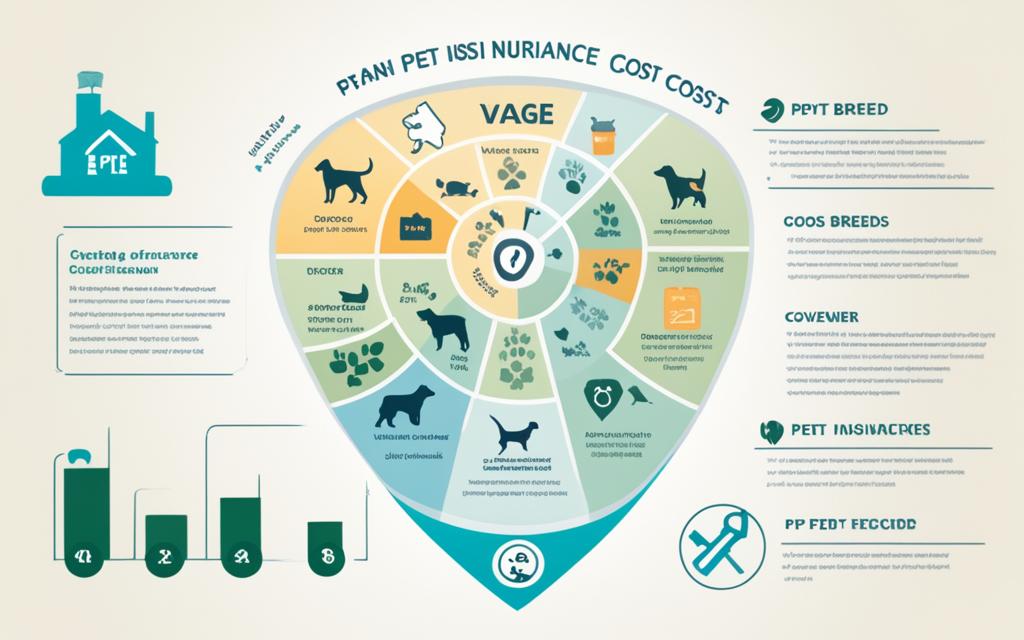The price of taking care of our furry friends is going up. Pet insurance is more important than ever. It can help pet owners feel secure, especially since one of every three pets needs urgent care yearly.1 This coverage can lower the stress of unexpected vet bills. It’s crucial to know about terms like deductibles, reimbursement rates, and policy limits. This knowledge helps pick the best insurance for your pet and budget.
Having a cat costs about $1,149 each year. For dogs, it’s roughly $1,391 annually.2 Pet health insurance ranges from $130.24 to $583.91 each year. The industry has seen prices jump by 11.4% in a year, faster than general costs.1 This makes pet insurance critical for those with pets.
Key Takeaways
- Pet insurance can provide financial security and peace of mind by limiting out-of-pocket expenses for unexpected vet bills.
- Understanding key insurance terms like deductibles, reimbursement rates, and limits is crucial to finding the right plan for your pet’s needs and your budget.
- The average annual cost of owning a cat is $1,149, while for a dog, it is about $1,391.
- The veterinary service sector has seen price spikes of up to 11.4% between June 2022 and June 2023, outpacing general inflation.
- Reviewing policy details carefully, including coverage types, exclusions, and limitations, is essential when selecting a pet insurance plan.
Understanding Pet Insurance
Pet insurance helps cover vet bills if your pet gets sick or hurt.3 It keeps pet owners from worrying too much about money when unexpected health issues arise.3
What is Pet Insurance?
It’s like health insurance for your furry friends.3 Pet insurance pays back some of the money you spend at the vet. This can be 70% to 90% of the cost, once you’ve paid your deductible.3
How Does Pet Insurance Work?
When your pet needs medical attention, you pay the vet first.3 Then, you ask your insurance for the money back by submitting a claim. Most of the time, you get the money within a week to nine days.1
There are different types of plans. This affects how much you pay each month3. Some plans also put a limit on how much they’ll pay every year, from $2,500 to no limit.3
Pet insurance covers a lot but not everything. For example, it won’t help with things your pet had before getting the insurance, general check-ups, or pet grooming34.
Having pet insurance means you won’t have to choose between your bank account and your pet’s health. It’s great for keeping your pets well without breaking the bank31.
Rising Costs of Veterinary Care
The yearly cost for a cat is about $1,149, and a dog costs roughly $1,391.5 These prices don’t cover one-time costs or extra services, like grooming and dental care. The cost of visiting the vet has increased by 11.4% between June 2022 and June 2023, higher than the average inflation rate.6 Emergency visits could range from $800 to $1,500, which is a big expense for pet owners.5
Average Annual Costs of Pet Ownership
Owning a cat costs about $1,149 a year, and a dog costs around $1,391 annually.57 These prices go up if you add one-time costs and extra services like professional grooming or dental work.
Inflation and Veterinary Service Pricing
Veterinary prices have increased by up to 11.4% from June 2022 to June 2023, surpassing the general inflation rate.7 This puts a financial strain on pet owners, as they must pay more for their pets’ healthcare. Emergency vet visits can be quite expensive, ranging from $800 to $1,500 on average, with even higher costs in some cases.5

Benefits of Pet Insurance
Pet insurance gives financial security for emergency veterinary visits2. It ensures access to top pet care without financial barriers2,8. It covers most of the cost for sudden vet visits. This stops owners from taking big loans or skipping necessary care due to money worries.2 It keeps pet parents calm and lets vets focus on giving great care without money problems getting in the way.8
Financial Security for Emergency Veterinary Visits
Having a cat costs about $1,149 yearly, and a dog costs $1,391.2 So, pet owners can stress over big vet bills, like $800 to $1,500 or more for emergency care.2 Pet insurance steps in to lower this financial risk. It helps cover a good part of these bills, making sure pets can get treated right away without leaving owners broke.
Access to Quality Care Without Financial Barriers
Pet insurance removes the worry of paying for vet care. This lets pet owners just focus on their pet’s health, not how much it costs.8 Pets get the best care possible. Vets can suggest and carry out the right treatments. They don’t have to cut corners because it’s too expensive.
Pet Insurance Considerations
When picking the right pet insurance, you must consider several key points. Pet insurance can address various needs, from mishaps to chronic health issues. It’s important to match coverage to your pet’s unique health risks.
Understanding what a policy doesn’t cover is crucial. This includes pre-existing conditions and specific breed issues. You should know about limitations such as age caps and waiting periods. Always remember that some conditions may not be covered at all.
Cost plays a big role in choosing the best insurance for your pet. Look at premium rates, deductibles, and annual limits. Think about how flexible the plan is and whether it offers discounts. Your payment options will also influence the overall price.
The service you get from the insurance company is vital too. Check their customer support availability and how you can file claims. Good pet insurance may even include benefits like seeing a vet over the phone.
Tools like Pawlicy Advisor can make comparing policies easier. They consider your pet’s details and health risks. This way, you can find coverage that directly meets your pet’s needs and fits your budget.
| Key Consideration | Insights |
|---|---|
| Coverage Types | Pet insurance can protect against many situations, including accidents, health conditions, and surgeries.9 |
| Exclusions and Limitations | Most policies avoid covering certain conditions, like ones your pet already had or those common to certain breeds. They also have age limits and wait times for new policies.910 |
| Cost Factors | What you pay can vary on several things, like how much the premium is, the deductible, and limits on payouts. Discounts for multiple pets are also an important factor.9 Deductibles and co-payment rates affect the final policy price too.10 |
| Customer Service | How well an insurance company helps you, like when and how you can contact them or how quickly they process claims, is very important.9 |
| Additional Benefits | Besides the usual coverages, some policies include benefits such as checkups, online vet visits, and direct payments to the vet.9 |
Evaluating these aspects thoroughly can help pet owners find the ideal insurance. This ensures full protection for pets without straining your budget. Ample coverage that matches your pet’s health situation is the goal.

Types of Pet Insurance Coverage
Choosing the right pet insurance means picking from three main options. These are accident coverage only, accident and illness plans, and ones with wellness add-ons. It’s key to understand what each offers to best care for your pets.
Accident-Only Plans
Accident-only plans are budget-friendly but they offer less. They help with costs from your pet’s physical injuries.4 These plans are cheaper than the next options because they limit what they cover.
Accident and Illness Plans
On the other hand, accident and illness plans cover more ground. They protect your pet from both accidents and illnesses.4 This type is the most commonly chosen.4 While they have higher costs each month, they give your pet better healthcare coverage.
Wellness Coverage Add-Ons
Adding wellness coverage to an accident and illness plan is an option.4 This extra covers regular services like shots and exams.4 It helps with the cost of routine care but won’t cover accidents or new illnesses.
Knowing what each option offers is crucial for the best pet care. Pick based on what your pet needs and what fits your budget.411
| Type of Coverage | Average Monthly Premium (2022) | Key Features |
|---|---|---|
| Accident-Only | $16.70 for dogs, $10.18 for cats11 | Covers expenses related to physical injuries only |
| Accident and Illness | $53.34 for dogs, $32.25 for cats11 | Comprehensive coverage for accidents and unexpected illnesses |
| Wellness Add-On | Varies by provider | Covers routine preventative care like vaccinations and check-ups |
What Pet Insurance Covers
Pet insurance is vital for your pets’ well-being. It covers a broad range of vet costs. And the top plans protect against accidents and injuries4. This includes getting hurt by bites, car accidents, and more.4
Accidents and Injuries
Top plans handle unexpected illnesses4 too. They guard against conditions like diabetes and cancer. They even cover hereditary and congenital conditions4. These might show up later in life.4
Illnesses and Hereditary Conditions
There’s more to these plans. They also help with surgical procedures12 and tests like X-rays. This ensures your pet gets the care they need, cost-free.12
Surgery and Diagnostics
But, it’s key to know what each plan offers. Check the details and possible limits. Looking over the policy documents41213 is a smart move. It helps you pick the right coverage for your pet’s health and your budget.

What Pet Insurance Doesn’t Cover
Pet insurance is great for sudden vet bills, but it doesn’t cover everything. It won’t pay for regular care like check-ups, shots, or teeth cleanings.14 Nor will it cover surgeries to fix or prevent another illness.
Also, pet insurance leaves out a lot. Things like surgeries to make a pet look different aren’t included. Neither are certain check-ups or special foods. Flea and heartworm medicines are on the list, too.14
So, if your pet gets sick before the policy starts, that problem’s on you. Most pet insurance won’t help with that. You could end up paying a lot for their care yourself.15
15 For pets having babies, insurance normally doesn’t handle the costs. This includes the care before they’re born, like check-ups, the birth, and any issues.15
Illnesses that shots could’ve stopped usually aren’t covered. This is because vet standards say these shots are a must. So, pet insurance skips out on these costs.15
16 For some sicknesses, like ones some dog breeds get a lot, insurance might not help. And if a pet dies, the insurance might not cover those bills.16
If a pet’s problem is already on one side of their body, it may not be covered. And, if your pet wasn’t vaccinated for this, the insurance might say no.16
16 Things like changing how a pet looks, some advanced care, or training might not get covered. Depending on how old or young a pet is, insurance might say they can’t help.16
It’s key to know what pet insurance won’t pay for. This helps you pick a plan that’s right for your pet and you.
Factors Affecting Pet Insurance Costs
Pet insurance costs depend on several factors. It’s important to know these to choose the best plan for your pet. The main factors are covered by the17 type and amount of insurance, the deductible, and limits. Also, the pet’s age, breed, and where you live matter.
Coverage Type and Amount
More coverage means higher premiums. Plans with accidents and illnesses coverage cost more.18 Lower deductibles and greater reimbursement raise costs. They offer more financial safety for pet owners.
Deductibles and Limits
Deductibles and policy limits affect costs greatly.18 Big deductibles equal cheaper monthly payments. Higher limits mean you pay more each month. It’s key to find the right balance between what you pay and how much you get.
Pet’s Age, Breed, and Location
Older pets, big dogs, and some locations have higher premiums.17 This is because they may need more healthcare, which can be costly. Pets like Great Danes or Bulldogs, prone to health issues, also see higher costs.
| Factor | Impact on Pet Insurance Costs |
|---|---|
| Coverage Type and Amount | More coverage and lower deductibles mean higher premiums.18 |
| Deductibles and Limits | Higher deductibles lower your premium, but more benefits raise it.18 |
| Pet’s Age, Breed, and Location | Older pets, big dogs, and certain areas mean higher costs.1719 |
Knowing these factors helps pet owners choose wisely. They can then find the best coverage that’s also affordable for their pets.

Pros and Cons of Pet Insurance
The pros of pet insurance are clear. They can cut down big on what you pay at the vet2. This helps you not worry so much about money when your pet is sick2. Plus, you don’t have to pick cash over your furry friend’s health2. Most plans are pretty affordable too2.
Still, there are some downsides. You often have to fork out the money first, then get paid back20. It won’t help with conditions your pet already had before you got the insurance2. Also, some health problems may not be part of the coverage2. For older pets or those already facing health issues, the cost could be high2.
| Pros of Pet Insurance | Cons of Pet Insurance |
|---|---|
Deciding on pet insurance needs some thought. You should check what it covers and costs. Make sure it fits both your pet’s needs and your budget.
How to Choose the Right Pet Insurance Plan
Choosing the right pet insurance means looking at what your pet needs. You should compare what different plans offer. This ensures your pet has the best coverage within your budget.9
Evaluate Your Pet’s Needs
First, assess your pet’s details like age and breed. Note any existing health issues. This helps in choosing the right coverage, like accident and illness plans.9 It’s key in finding a plan that fits your pet’s unique needs.21
Compare Providers and Policies
After knowing what your pet needs, look at different insurers’ policies. Check the coverage details, like how much they cover and limits. Also, see what’s not covered.9 Keep an eye on the kinds of health concerns covered. This ensures your pet is fully protected.9
Consider Cost and Coverage Balance
Next, think about the cost and the protection the plan gives. Plans with lower deductibles and more coverage might cost more each month. But they can save you money in the long term.9 Don’t forget to look for discounts, especially if you have more than one pet. This can help you get good coverage at a lower price.9
By looking at what your pet needs, comparing insurance, and balancing cost and coverage, you’re on your way to picking the perfect plan. This ensures your furry friend is well taken care of.21

Conclusion
Pet insurance is a smart choice for many pet owners. It ensures their pets can get proper care without financial worries. In Ontario, dog insurance costs about $55 per month. Cat insurance, on the other hand, is around $30 monthly.22
Pet insurance varies in what it covers. It may not pay for all costs, but it does lower the financial burden of pet care. Keep in mind, plans can have deductibles and may not cover pre-existing conditions.22 There’s also a waiting period for claims to start. Insuring young pets is often cheaper and simpler too.
It’s important to look into what a pet insurance plan includes and what it costs. This can help manage the growing expenses of vet care. Prices for coverage can be between $20 and $50 monthly. Some plans might even help pay for regular vet visits and shots.23 In the end, pet insurance is key for keeping our pets healthy and happy.
FAQ
What is pet insurance?
How does pet insurance work?
What are the average annual costs of owning a pet?
FAQ
What is pet insurance?
Pet insurance helps pay for a pet’s medical bills if they get sick or hurt. It makes sure pet owners are not left with a big bill from the vet. This gives people less to worry about when their pet needs help.
How does pet insurance work?
Pet owners pay for vet visits first. Then they ask their insurance company to cover some of the cost. Most plans will pay back 70-100% after a small part of the bill is paid by the owner.
What are the average annual costs of owning a pet?
Owning a cat costs about
FAQ
What is pet insurance?
Pet insurance helps pay for a pet’s medical bills if they get sick or hurt. It makes sure pet owners are not left with a big bill from the vet. This gives people less to worry about when their pet needs help.
How does pet insurance work?
Pet owners pay for vet visits first. Then they ask their insurance company to cover some of the cost. Most plans will pay back 70-100% after a small part of the bill is paid by the owner.
What are the average annual costs of owning a pet?
Owning a cat costs about $1,149 a year. A dog costs roughly $1,391 annually. These prices do not include big one-time buys or special services like grooming.
What are the key benefits of pet insurance?
Pet insurance takes the stress out of paying for emergency care. It helps pet owners keep their furry friends healthy. It means you don’t have to worry about big bills or debt when your pet is sick or hurt.
What are the main types of pet insurance coverage?
There are three main types of pet insurance. They cover only accidents, accidents and illness, or add-on wellness care. With these plans, you can choose what fits your pet’s needs best.
What does pet insurance generally cover?
Pet insurance helps with accidents, sickness, and even surgery. It also covers tests like x-rays or MRIs. Despite this, each plan is different, so always check the details.
What doesn’t pet insurance cover?
Not everything is covered by pet insurance. Pre-existing conditions and some treatments are not included. Neither are cosmetic surgeries or expenses not related to the vet.
What factors can impact the cost of pet insurance premiums?
Many things can change how much pet insurance costs. This includes the type of coverage, your pet’s age and breed, and where you live. It’s a good idea to look at different options before deciding.
What are the pros and cons of pet insurance?
Pet insurance cuts down on big vet bills significantly. It offers peace of mind that your pet’s health needs are covered. Yet, not everything is perfect. You usually pay first and get money back later. Also, some health problems aren’t covered. For older pets or those already sick, it might cost more or not offer as much help.
How do I choose the right pet insurance plan?
Picking the best insurance for your pet means looking at their health needs. You should compare what different plans offer and how much you pay. Find the best match that keeps your pet healthy and meets your budget.
,149 a year. A dog costs roughly
FAQ
What is pet insurance?
Pet insurance helps pay for a pet’s medical bills if they get sick or hurt. It makes sure pet owners are not left with a big bill from the vet. This gives people less to worry about when their pet needs help.
How does pet insurance work?
Pet owners pay for vet visits first. Then they ask their insurance company to cover some of the cost. Most plans will pay back 70-100% after a small part of the bill is paid by the owner.
What are the average annual costs of owning a pet?
Owning a cat costs about $1,149 a year. A dog costs roughly $1,391 annually. These prices do not include big one-time buys or special services like grooming.
What are the key benefits of pet insurance?
Pet insurance takes the stress out of paying for emergency care. It helps pet owners keep their furry friends healthy. It means you don’t have to worry about big bills or debt when your pet is sick or hurt.
What are the main types of pet insurance coverage?
There are three main types of pet insurance. They cover only accidents, accidents and illness, or add-on wellness care. With these plans, you can choose what fits your pet’s needs best.
What does pet insurance generally cover?
Pet insurance helps with accidents, sickness, and even surgery. It also covers tests like x-rays or MRIs. Despite this, each plan is different, so always check the details.
What doesn’t pet insurance cover?
Not everything is covered by pet insurance. Pre-existing conditions and some treatments are not included. Neither are cosmetic surgeries or expenses not related to the vet.
What factors can impact the cost of pet insurance premiums?
Many things can change how much pet insurance costs. This includes the type of coverage, your pet’s age and breed, and where you live. It’s a good idea to look at different options before deciding.
What are the pros and cons of pet insurance?
Pet insurance cuts down on big vet bills significantly. It offers peace of mind that your pet’s health needs are covered. Yet, not everything is perfect. You usually pay first and get money back later. Also, some health problems aren’t covered. For older pets or those already sick, it might cost more or not offer as much help.
How do I choose the right pet insurance plan?
Picking the best insurance for your pet means looking at their health needs. You should compare what different plans offer and how much you pay. Find the best match that keeps your pet healthy and meets your budget.
,391 annually. These prices do not include big one-time buys or special services like grooming.
What are the key benefits of pet insurance?
Pet insurance takes the stress out of paying for emergency care. It helps pet owners keep their furry friends healthy. It means you don’t have to worry about big bills or debt when your pet is sick or hurt.
What are the main types of pet insurance coverage?
There are three main types of pet insurance. They cover only accidents, accidents and illness, or add-on wellness care. With these plans, you can choose what fits your pet’s needs best.
What does pet insurance generally cover?
Pet insurance helps with accidents, sickness, and even surgery. It also covers tests like x-rays or MRIs. Despite this, each plan is different, so always check the details.
What doesn’t pet insurance cover?
Not everything is covered by pet insurance. Pre-existing conditions and some treatments are not included. Neither are cosmetic surgeries or expenses not related to the vet.
What factors can impact the cost of pet insurance premiums?
Many things can change how much pet insurance costs. This includes the type of coverage, your pet’s age and breed, and where you live. It’s a good idea to look at different options before deciding.
What are the pros and cons of pet insurance?
Pet insurance cuts down on big vet bills significantly. It offers peace of mind that your pet’s health needs are covered. Yet, not everything is perfect. You usually pay first and get money back later. Also, some health problems aren’t covered. For older pets or those already sick, it might cost more or not offer as much help.
How do I choose the right pet insurance plan?
Picking the best insurance for your pet means looking at their health needs. You should compare what different plans offer and how much you pay. Find the best match that keeps your pet healthy and meets your budget.
FAQ
What is pet insurance?
Pet insurance helps pay for a pet’s medical bills if they get sick or hurt. It makes sure pet owners are not left with a big bill from the vet. This gives people less to worry about when their pet needs help.
How does pet insurance work?
Pet owners pay for vet visits first. Then they ask their insurance company to cover some of the cost. Most plans will pay back 70-100% after a small part of the bill is paid by the owner.
What are the average annual costs of owning a pet?
Owning a cat costs about
FAQ
What is pet insurance?
Pet insurance helps pay for a pet’s medical bills if they get sick or hurt. It makes sure pet owners are not left with a big bill from the vet. This gives people less to worry about when their pet needs help.
How does pet insurance work?
Pet owners pay for vet visits first. Then they ask their insurance company to cover some of the cost. Most plans will pay back 70-100% after a small part of the bill is paid by the owner.
What are the average annual costs of owning a pet?
Owning a cat costs about $1,149 a year. A dog costs roughly $1,391 annually. These prices do not include big one-time buys or special services like grooming.
What are the key benefits of pet insurance?
Pet insurance takes the stress out of paying for emergency care. It helps pet owners keep their furry friends healthy. It means you don’t have to worry about big bills or debt when your pet is sick or hurt.
What are the main types of pet insurance coverage?
There are three main types of pet insurance. They cover only accidents, accidents and illness, or add-on wellness care. With these plans, you can choose what fits your pet’s needs best.
What does pet insurance generally cover?
Pet insurance helps with accidents, sickness, and even surgery. It also covers tests like x-rays or MRIs. Despite this, each plan is different, so always check the details.
What doesn’t pet insurance cover?
Not everything is covered by pet insurance. Pre-existing conditions and some treatments are not included. Neither are cosmetic surgeries or expenses not related to the vet.
What factors can impact the cost of pet insurance premiums?
Many things can change how much pet insurance costs. This includes the type of coverage, your pet’s age and breed, and where you live. It’s a good idea to look at different options before deciding.
What are the pros and cons of pet insurance?
Pet insurance cuts down on big vet bills significantly. It offers peace of mind that your pet’s health needs are covered. Yet, not everything is perfect. You usually pay first and get money back later. Also, some health problems aren’t covered. For older pets or those already sick, it might cost more or not offer as much help.
How do I choose the right pet insurance plan?
Picking the best insurance for your pet means looking at their health needs. You should compare what different plans offer and how much you pay. Find the best match that keeps your pet healthy and meets your budget.
,149 a year. A dog costs roughly
FAQ
What is pet insurance?
Pet insurance helps pay for a pet’s medical bills if they get sick or hurt. It makes sure pet owners are not left with a big bill from the vet. This gives people less to worry about when their pet needs help.
How does pet insurance work?
Pet owners pay for vet visits first. Then they ask their insurance company to cover some of the cost. Most plans will pay back 70-100% after a small part of the bill is paid by the owner.
What are the average annual costs of owning a pet?
Owning a cat costs about $1,149 a year. A dog costs roughly $1,391 annually. These prices do not include big one-time buys or special services like grooming.
What are the key benefits of pet insurance?
Pet insurance takes the stress out of paying for emergency care. It helps pet owners keep their furry friends healthy. It means you don’t have to worry about big bills or debt when your pet is sick or hurt.
What are the main types of pet insurance coverage?
There are three main types of pet insurance. They cover only accidents, accidents and illness, or add-on wellness care. With these plans, you can choose what fits your pet’s needs best.
What does pet insurance generally cover?
Pet insurance helps with accidents, sickness, and even surgery. It also covers tests like x-rays or MRIs. Despite this, each plan is different, so always check the details.
What doesn’t pet insurance cover?
Not everything is covered by pet insurance. Pre-existing conditions and some treatments are not included. Neither are cosmetic surgeries or expenses not related to the vet.
What factors can impact the cost of pet insurance premiums?
Many things can change how much pet insurance costs. This includes the type of coverage, your pet’s age and breed, and where you live. It’s a good idea to look at different options before deciding.
What are the pros and cons of pet insurance?
Pet insurance cuts down on big vet bills significantly. It offers peace of mind that your pet’s health needs are covered. Yet, not everything is perfect. You usually pay first and get money back later. Also, some health problems aren’t covered. For older pets or those already sick, it might cost more or not offer as much help.
How do I choose the right pet insurance plan?
Picking the best insurance for your pet means looking at their health needs. You should compare what different plans offer and how much you pay. Find the best match that keeps your pet healthy and meets your budget.
,391 annually. These prices do not include big one-time buys or special services like grooming.
What are the key benefits of pet insurance?
Pet insurance takes the stress out of paying for emergency care. It helps pet owners keep their furry friends healthy. It means you don’t have to worry about big bills or debt when your pet is sick or hurt.
What are the main types of pet insurance coverage?
There are three main types of pet insurance. They cover only accidents, accidents and illness, or add-on wellness care. With these plans, you can choose what fits your pet’s needs best.
What does pet insurance generally cover?
Pet insurance helps with accidents, sickness, and even surgery. It also covers tests like x-rays or MRIs. Despite this, each plan is different, so always check the details.
What doesn’t pet insurance cover?
Not everything is covered by pet insurance. Pre-existing conditions and some treatments are not included. Neither are cosmetic surgeries or expenses not related to the vet.
What factors can impact the cost of pet insurance premiums?
Many things can change how much pet insurance costs. This includes the type of coverage, your pet’s age and breed, and where you live. It’s a good idea to look at different options before deciding.
What are the pros and cons of pet insurance?
Pet insurance cuts down on big vet bills significantly. It offers peace of mind that your pet’s health needs are covered. Yet, not everything is perfect. You usually pay first and get money back later. Also, some health problems aren’t covered. For older pets or those already sick, it might cost more or not offer as much help.
How do I choose the right pet insurance plan?
Picking the best insurance for your pet means looking at their health needs. You should compare what different plans offer and how much you pay. Find the best match that keeps your pet healthy and meets your budget.
FAQ
What is pet insurance?
Pet insurance helps pay for a pet’s medical bills if they get sick or hurt. It makes sure pet owners are not left with a big bill from the vet. This gives people less to worry about when their pet needs help.
How does pet insurance work?
Pet owners pay for vet visits first. Then they ask their insurance company to cover some of the cost. Most plans will pay back 70-100% after a small part of the bill is paid by the owner.
What are the average annual costs of owning a pet?
Owning a cat costs about
FAQ
What is pet insurance?
Pet insurance helps pay for a pet’s medical bills if they get sick or hurt. It makes sure pet owners are not left with a big bill from the vet. This gives people less to worry about when their pet needs help.
How does pet insurance work?
Pet owners pay for vet visits first. Then they ask their insurance company to cover some of the cost. Most plans will pay back 70-100% after a small part of the bill is paid by the owner.
What are the average annual costs of owning a pet?
Owning a cat costs about $1,149 a year. A dog costs roughly $1,391 annually. These prices do not include big one-time buys or special services like grooming.
What are the key benefits of pet insurance?
Pet insurance takes the stress out of paying for emergency care. It helps pet owners keep their furry friends healthy. It means you don’t have to worry about big bills or debt when your pet is sick or hurt.
What are the main types of pet insurance coverage?
There are three main types of pet insurance. They cover only accidents, accidents and illness, or add-on wellness care. With these plans, you can choose what fits your pet’s needs best.
What does pet insurance generally cover?
Pet insurance helps with accidents, sickness, and even surgery. It also covers tests like x-rays or MRIs. Despite this, each plan is different, so always check the details.
What doesn’t pet insurance cover?
Not everything is covered by pet insurance. Pre-existing conditions and some treatments are not included. Neither are cosmetic surgeries or expenses not related to the vet.
What factors can impact the cost of pet insurance premiums?
Many things can change how much pet insurance costs. This includes the type of coverage, your pet’s age and breed, and where you live. It’s a good idea to look at different options before deciding.
What are the pros and cons of pet insurance?
Pet insurance cuts down on big vet bills significantly. It offers peace of mind that your pet’s health needs are covered. Yet, not everything is perfect. You usually pay first and get money back later. Also, some health problems aren’t covered. For older pets or those already sick, it might cost more or not offer as much help.
How do I choose the right pet insurance plan?
Picking the best insurance for your pet means looking at their health needs. You should compare what different plans offer and how much you pay. Find the best match that keeps your pet healthy and meets your budget.
,149 a year. A dog costs roughly
FAQ
What is pet insurance?
Pet insurance helps pay for a pet’s medical bills if they get sick or hurt. It makes sure pet owners are not left with a big bill from the vet. This gives people less to worry about when their pet needs help.
How does pet insurance work?
Pet owners pay for vet visits first. Then they ask their insurance company to cover some of the cost. Most plans will pay back 70-100% after a small part of the bill is paid by the owner.
What are the average annual costs of owning a pet?
Owning a cat costs about $1,149 a year. A dog costs roughly $1,391 annually. These prices do not include big one-time buys or special services like grooming.
What are the key benefits of pet insurance?
Pet insurance takes the stress out of paying for emergency care. It helps pet owners keep their furry friends healthy. It means you don’t have to worry about big bills or debt when your pet is sick or hurt.
What are the main types of pet insurance coverage?
There are three main types of pet insurance. They cover only accidents, accidents and illness, or add-on wellness care. With these plans, you can choose what fits your pet’s needs best.
What does pet insurance generally cover?
Pet insurance helps with accidents, sickness, and even surgery. It also covers tests like x-rays or MRIs. Despite this, each plan is different, so always check the details.
What doesn’t pet insurance cover?
Not everything is covered by pet insurance. Pre-existing conditions and some treatments are not included. Neither are cosmetic surgeries or expenses not related to the vet.
What factors can impact the cost of pet insurance premiums?
Many things can change how much pet insurance costs. This includes the type of coverage, your pet’s age and breed, and where you live. It’s a good idea to look at different options before deciding.
What are the pros and cons of pet insurance?
Pet insurance cuts down on big vet bills significantly. It offers peace of mind that your pet’s health needs are covered. Yet, not everything is perfect. You usually pay first and get money back later. Also, some health problems aren’t covered. For older pets or those already sick, it might cost more or not offer as much help.
How do I choose the right pet insurance plan?
Picking the best insurance for your pet means looking at their health needs. You should compare what different plans offer and how much you pay. Find the best match that keeps your pet healthy and meets your budget.
,391 annually. These prices do not include big one-time buys or special services like grooming.
What are the key benefits of pet insurance?
Pet insurance takes the stress out of paying for emergency care. It helps pet owners keep their furry friends healthy. It means you don’t have to worry about big bills or debt when your pet is sick or hurt.
What are the main types of pet insurance coverage?
There are three main types of pet insurance. They cover only accidents, accidents and illness, or add-on wellness care. With these plans, you can choose what fits your pet’s needs best.
What does pet insurance generally cover?
Pet insurance helps with accidents, sickness, and even surgery. It also covers tests like x-rays or MRIs. Despite this, each plan is different, so always check the details.
What doesn’t pet insurance cover?
Not everything is covered by pet insurance. Pre-existing conditions and some treatments are not included. Neither are cosmetic surgeries or expenses not related to the vet.
What factors can impact the cost of pet insurance premiums?
Many things can change how much pet insurance costs. This includes the type of coverage, your pet’s age and breed, and where you live. It’s a good idea to look at different options before deciding.
What are the pros and cons of pet insurance?
Pet insurance cuts down on big vet bills significantly. It offers peace of mind that your pet’s health needs are covered. Yet, not everything is perfect. You usually pay first and get money back later. Also, some health problems aren’t covered. For older pets or those already sick, it might cost more or not offer as much help.
How do I choose the right pet insurance plan?
Picking the best insurance for your pet means looking at their health needs. You should compare what different plans offer and how much you pay. Find the best match that keeps your pet healthy and meets your budget.
FAQ
What is pet insurance?
Pet insurance helps pay for a pet’s medical bills if they get sick or hurt. It makes sure pet owners are not left with a big bill from the vet. This gives people less to worry about when their pet needs help.
How does pet insurance work?
Pet owners pay for vet visits first. Then they ask their insurance company to cover some of the cost. Most plans will pay back 70-100% after a small part of the bill is paid by the owner.
What are the average annual costs of owning a pet?
Owning a cat costs about
FAQ
What is pet insurance?
Pet insurance helps pay for a pet’s medical bills if they get sick or hurt. It makes sure pet owners are not left with a big bill from the vet. This gives people less to worry about when their pet needs help.
How does pet insurance work?
Pet owners pay for vet visits first. Then they ask their insurance company to cover some of the cost. Most plans will pay back 70-100% after a small part of the bill is paid by the owner.
What are the average annual costs of owning a pet?
Owning a cat costs about $1,149 a year. A dog costs roughly $1,391 annually. These prices do not include big one-time buys or special services like grooming.
What are the key benefits of pet insurance?
Pet insurance takes the stress out of paying for emergency care. It helps pet owners keep their furry friends healthy. It means you don’t have to worry about big bills or debt when your pet is sick or hurt.
What are the main types of pet insurance coverage?
There are three main types of pet insurance. They cover only accidents, accidents and illness, or add-on wellness care. With these plans, you can choose what fits your pet’s needs best.
What does pet insurance generally cover?
Pet insurance helps with accidents, sickness, and even surgery. It also covers tests like x-rays or MRIs. Despite this, each plan is different, so always check the details.
What doesn’t pet insurance cover?
Not everything is covered by pet insurance. Pre-existing conditions and some treatments are not included. Neither are cosmetic surgeries or expenses not related to the vet.
What factors can impact the cost of pet insurance premiums?
Many things can change how much pet insurance costs. This includes the type of coverage, your pet’s age and breed, and where you live. It’s a good idea to look at different options before deciding.
What are the pros and cons of pet insurance?
Pet insurance cuts down on big vet bills significantly. It offers peace of mind that your pet’s health needs are covered. Yet, not everything is perfect. You usually pay first and get money back later. Also, some health problems aren’t covered. For older pets or those already sick, it might cost more or not offer as much help.
How do I choose the right pet insurance plan?
Picking the best insurance for your pet means looking at their health needs. You should compare what different plans offer and how much you pay. Find the best match that keeps your pet healthy and meets your budget.
,149 a year. A dog costs roughly
FAQ
What is pet insurance?
Pet insurance helps pay for a pet’s medical bills if they get sick or hurt. It makes sure pet owners are not left with a big bill from the vet. This gives people less to worry about when their pet needs help.
How does pet insurance work?
Pet owners pay for vet visits first. Then they ask their insurance company to cover some of the cost. Most plans will pay back 70-100% after a small part of the bill is paid by the owner.
What are the average annual costs of owning a pet?
Owning a cat costs about $1,149 a year. A dog costs roughly $1,391 annually. These prices do not include big one-time buys or special services like grooming.
What are the key benefits of pet insurance?
Pet insurance takes the stress out of paying for emergency care. It helps pet owners keep their furry friends healthy. It means you don’t have to worry about big bills or debt when your pet is sick or hurt.
What are the main types of pet insurance coverage?
There are three main types of pet insurance. They cover only accidents, accidents and illness, or add-on wellness care. With these plans, you can choose what fits your pet’s needs best.
What does pet insurance generally cover?
Pet insurance helps with accidents, sickness, and even surgery. It also covers tests like x-rays or MRIs. Despite this, each plan is different, so always check the details.
What doesn’t pet insurance cover?
Not everything is covered by pet insurance. Pre-existing conditions and some treatments are not included. Neither are cosmetic surgeries or expenses not related to the vet.
What factors can impact the cost of pet insurance premiums?
Many things can change how much pet insurance costs. This includes the type of coverage, your pet’s age and breed, and where you live. It’s a good idea to look at different options before deciding.
What are the pros and cons of pet insurance?
Pet insurance cuts down on big vet bills significantly. It offers peace of mind that your pet’s health needs are covered. Yet, not everything is perfect. You usually pay first and get money back later. Also, some health problems aren’t covered. For older pets or those already sick, it might cost more or not offer as much help.
How do I choose the right pet insurance plan?
Picking the best insurance for your pet means looking at their health needs. You should compare what different plans offer and how much you pay. Find the best match that keeps your pet healthy and meets your budget.
,391 annually. These prices do not include big one-time buys or special services like grooming.
What are the key benefits of pet insurance?
Pet insurance takes the stress out of paying for emergency care. It helps pet owners keep their furry friends healthy. It means you don’t have to worry about big bills or debt when your pet is sick or hurt.
What are the main types of pet insurance coverage?
There are three main types of pet insurance. They cover only accidents, accidents and illness, or add-on wellness care. With these plans, you can choose what fits your pet’s needs best.
What does pet insurance generally cover?
Pet insurance helps with accidents, sickness, and even surgery. It also covers tests like x-rays or MRIs. Despite this, each plan is different, so always check the details.
What doesn’t pet insurance cover?
Not everything is covered by pet insurance. Pre-existing conditions and some treatments are not included. Neither are cosmetic surgeries or expenses not related to the vet.
What factors can impact the cost of pet insurance premiums?
Many things can change how much pet insurance costs. This includes the type of coverage, your pet’s age and breed, and where you live. It’s a good idea to look at different options before deciding.
What are the pros and cons of pet insurance?
Pet insurance cuts down on big vet bills significantly. It offers peace of mind that your pet’s health needs are covered. Yet, not everything is perfect. You usually pay first and get money back later. Also, some health problems aren’t covered. For older pets or those already sick, it might cost more or not offer as much help.
How do I choose the right pet insurance plan?
Picking the best insurance for your pet means looking at their health needs. You should compare what different plans offer and how much you pay. Find the best match that keeps your pet healthy and meets your budget.
What are the key benefits of pet insurance?
What are the main types of pet insurance coverage?
What does pet insurance generally cover?
What doesn’t pet insurance cover?
What factors can impact the cost of pet insurance premiums?
What are the pros and cons of pet insurance?
How do I choose the right pet insurance plan?
Source Links
- https://www.pawlicy.com/blog/what-is-pet-insurance/
- https://www.empower.com/the-currency/play/pros-cons-pet-insurance
- https://www.usnews.com/insurance/pet-insurance/what-is-pet-insurance
- https://www.nerdwallet.com/article/insurance/pet-insurance-coverage
- https://www.maybeckvet.com/services/pets/blog/protect-your-pets-against-rising-health-care-costs
- https://www.veterinarypracticenews.com/pet-insurance-trends-developments/
- https://www.ncbi.nlm.nih.gov/pmc/articles/PMC7401533/
- https://www.avma.org/resources-tools/pet-owners/petcare/do-you-need-pet-insurance
- https://www.aaha.org/resources/pet-insurance/how-do-i-choose-the-right-pet-insurance/
- https://www.insurance.ca.gov/01-consumers/105-type/8-pet/pet-qa.cfm
- https://www.investopedia.com/types-of-pet-insurance-7568108
- https://www.forbes.com/advisor/pet-insurance/what-does-pet-insurance-cover/
- https://www.aspcapetinsurance.com/research-and-compare/pet-insurance-basics/whats-covered/
- https://www.cbsnews.com/news/what-pet-insurance-does-and-doesnt-cover/
- https://money.com/what-pet-insurance-wont-cover/
- https://www.investopedia.com/what-is-not-covered-by-pet-insurance-5077294
- https://www.cbsnews.com/news/what-affects-pet-insurance-costs/
- https://lendedu.com/blog/factors-that-impact-pet-insurance-cost/
- https://abbateins.com/5-factors-that-impact-pet-insurance-costs/
- https://www.investopedia.com/pros-and-cons-of-pet-insurance-8606317
- https://www.aspcapetinsurance.com/resources/pet-insurance-buyers-guide/
- https://pawscanada.ca/blog/understanding-pet-insurance-practical-suggestions/
- https://www.pethonesty.com/blogs/blog/is-pet-insurance-worth-it




